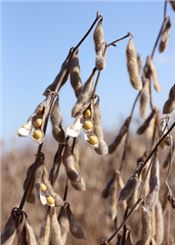|
Early Soybean Yields Reflect Weather Extremes
STARKVILLE, MISS.
Erratic yields in Mississippi’s early-planted soybean crop reflect the extremes of temperature and rainfall farmers faced during the spring and summer of 2015.
“This season was one of extremes,” said Trent Irby, soybean specialist with the Mississippi State University Extension Service. “We went from cool, wet conditions in early spring to hot and dry during a critical point of the season, and that has taken a toll on yield for some of our acres.”
The state is expected to harvest 2.33 million acres of soybeans this fall. The U.S. Department of Agriculture estimated the crop was 59 percent harvested by Sept. 29, and 66 percent of it looks to be in good or excellent condition. However, 11 percent is projected to be in poor or very poor condition.
Last year, Mississippi soybean farmers set a record, harvesting 52 bushels an acre. USDA is projecting a state average yield of 48 bushels an acre this year.
“Our yield reports so far are widely scattered,” Irby said. “We have seen really solid yields in places, but some fields are yielding much lower than what we have seen in the last few years.”
Irby said spring rains divided the planting season into three phases. Significant rains required farmers to plant as best they could in relatively dry periods during April, May and June or later. Some fields required replanting very late into the summer.
Alex Deason, Extension agriculture agent in Sunflower County, said the northern and southern parts of that county had distinctly different growing seasons.
“Growers in the south were able to jump in and plant in the early April window, and even on dryland acres, they ended up with yields that were, if not equal to last year, only a couple of bushels off,” Deason said. “The growers in the north end of the county caught a lot of showers that pushed planting back to mid- to late May, causing this crop to flower and enter reproductive stages in some extreme temperatures with little rainfall. These yields have been down 10-20 bushels in some cases.
“The double-crop beans took the biggest hit,” he said. “Wheat harvest was pushed later due to unfavorable spring conditions, and when the beans were finally planted, they received only one significant rainfall on the weekend of July 4, and very little precipitation fell after that. There’s a lot of wheat beans that did not fill a pod.”
Deason said soybeans in some fields looked excellent through early July, but plants then shut down because of dry weather and producers’ inability to irrigate on schedule.
“Producers will put a combine in the field to harvest some late beans, while others will disc and begin field prep because it would not be economical to harvest,” he said.
Irby said growers have dealt with weed, insect and disease issues this season. Timely weed management was especially challenging with the wet spring weather.
“Our growers had to deal with some very small windows early this season when field work could be done,” he said. “It was difficult to perform all of the operations necessary for effective weed control programs in the limited time available between rains.”
Brian Williams, Extension agricultural economist, said soybean prices are slightly lower than they were at this time last year, but they have remained steady overall.
“There is a lot of uncertainty in the market right now, which could cause some volatility as we move through harvest,” Williams said. “We have some areas of the country that look to have a great crop, while other areas were hurt from a wet spring.”
As of Sept. 29, Greenville cash soybeans were selling for $9.14 a bushel, and November futures were trading for $8.92 per bushel. Last year, Greenville cash soybean prices were $9.60 a bushel, and November futures were $9.37 a bushel.
“Decreasing stocks from the 2014 crop have helped prices, but a stronger dollar has hurt export demand when compared to Brazil’s soybean crop,” he said. ∆

Harvest of the state’s soybean crop was about two-thirds complete
by the first of October. These soybeans were drying out Sept. 19, 2015
at the Mississippi State University R.R. Foil Plant Science Research Center.
Photo by MSU Ag Communications/Kat Lawrence
|
|